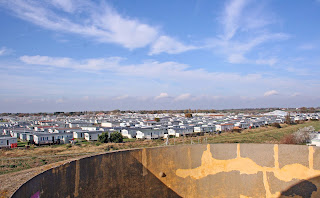As I was walking through the Corralitas Red Car Property I spotted the above chair, not very close to and apparently not belonging to any house. I wasn’t sure whether it had been deliberately put there by someone who thought this was a perfect place to sit, or whether it had simply been dumped and tossed down the hill.
And it struck me, not exactly for the first time, that as I go walking I often see abandoned chairs or sofas, and once in a while I photograph them, though not always. It hasn’t quite turned into an art project as yet, though one day it may do.
In fact when I went to walk around the chapel that features in the Cabarat Voltaire video of Sensoria, with my pals Steve and Julia, we found a complete three piece suite left on the forecourt of an empty workshop that was up for rent. It struck all of us as pretty funny. How did it get here? It certainly didn’t look like the kind of thing that would ever have been inside the workshop. So had somebody gone to the trouble of loading the thing into a van, transporting it here and there placing it on the forecourt? Would it have been any more trouble to take it to the dump?
In Edgelands, a book which I’m still gamely poking around in, the authors (Paul Farley and Michael Symmons Roberts) write, “The feral car seat is another emblem of edgelands. Every childhood should have one. In an age before computer games, sitting in one of these, making engine noises was as close as a child could get to the open road. Or you could strap the seat to a go-cart and find a slope. And you can rock them on their metal runners, survey your empire of feral knotweed, balsam poppies and willow herb like an old hillbilly on a wooden veranda.”
Well yes indeed, though as I’ve observed before many of the phenomena the boys identify as features of edgelands are present right in the middle of cities. That car seat above was located just off Hollywood Boulevard, outside a marijuana dispensary. The sofa below was on Los Feliz Boulevard, a fairly swanky LA street.
I also see plenty of abandoned televisions and computer monitors when I’m out walking. This is more understandable in many ways: you can’t just put them in the trash – the garbage men won’t take them. They need to be “recycled.” When we bought our new TV the delivery men said they’d gladly take the old one away if we paid them fifty dollars. We decided to save the money and the old TV sits in the junk room and every now and again we think we should do something about it but we never do. Although the “something” thus far has never involved thinking about taking it out into the street and leaving at the side of the road.
As a man who does a certain amount of walking in the desert, I do of course come across lots of human jetsom, including this TV.
The TV here has been used for target practice, and as an Englishman I find the whole idea of hauling things into the middle of nowhere in order to shoot at them pretty alien, although the evidence is that it strikes many Americans as perfectly standard behavior.
There’s a passage in Rayner Banham’s “Scenes in America Deserta” where he reckons that people in the desert only shoot manmade things. His observation is that they shoot the hell out of chairs and TVs and road signs, and certainly out of cars, but the things that are native and natural to the desert tend to be left alone. I’m sure this isn’t literally true, the odd cactus surely gets shot up, but I do suspect he’s on to something.
I don’t think Banham was much of a walker. All the images I’ve ever see of him, show him in a car or on one those very cool sixties bikes. These days however there are various “Reyner Banham Loves Los Angeles” tours run by Esotouric, that involve walking as well as bus riding. “Please be prepared to talk a stroll,” the website says rather gently and plaintively: they’re dealing with Angelinos after all.
















































